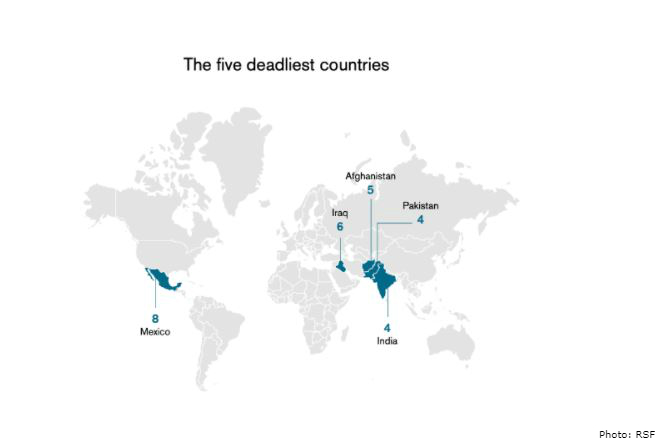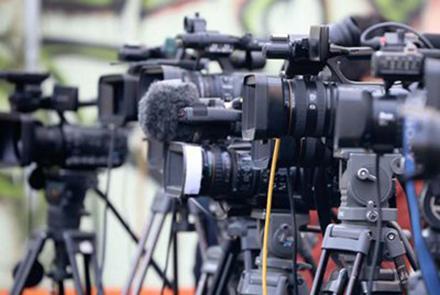50 journalists were killed worldwide in 2020, according to a report of abusive treatment and violence against journalists, published Monday by Reporters Without Borders (RSF).
While the number of journalists killed in countries at war continues to fall, more are being murdered in countries not at war.
It highlighted murders in Mexico, India and Pakistan.
“RSF tallied 50 cases of journalists killed in connection with their work from January 1 to December 15, 2020, a number similar to 2019 (when 53 journalists were killed), although fewer journalists have been in the field this year because of the Covid-19 pandemic,” the report said.
More journalists are being killed in countries considered to be “at peace.”
In 2016, 58% of media fatalities took place in war zones. Now only 32% of the fatalities are in war-torn countries such as Syria or Yemen or in countries with low or medium-intensity conflicts such as Afghanistan and Iraq.
In other words, 68% (more than two thirds) of the fatalities are in countries “at peace,” above all Mexico (with eight journalists killed), India (four), the Philippines (three) and Honduras (three).
84% of those killed this year were "deliberately targeted" for their work, RSF said in its annual report, compared to 63% in 2019.
"For several years now, Reporters Without Borders has noted that investigative journalists are really in the crosshairs of states, or cartels," said Pauline Ades-Mevel, RSF editor-in-chief.

In Afghanistan, December was marked by another execution, that of Malalai Maiwand, a journalist with Enekaas TV and representative of the Centre for the Protection of Afghan Women Journalists (CPAWJ) in the eastern city of Jalalabad, the report said.
She was the victim of an execution-style murder when she and her driver were shot dead by gunmen near her home. Mohammad Aliyas Dayee, a journalist with the Pashto-language section of Radio Azadi, the Afghan branch of Radio Free Europe/Radio Liberty (RFE/RL), was also killed by a bomb placed under his car in the southwestern city of Lashkargah in November.
Violence against journalists and media has increased in Afghanistan in recent months, although a respite might have been expected as a result of the peace talks between the Taliban and the Afghan government. Three other journalists were killed by car bombs and explosions this year. While none of these killings have been claimed, Afghan civil society members continue to denounce a campaign of terror against those who criticize religious obscurantism.
In India, Rakesh “Nirbhik” Singh, a reporter for the Rashtriya Swaroop newspaper, was burned alive in December after being doused with a highly flammable, alcohol-based hand sanitiser in his home in the northern state of Uttar Pradesh by men sent by a local official whose corrupt practices he had criticised, while Isravel Moses, a TV reporter in the southeastern state of Tamil Nadu, was hacked to death with machetes.
In Iran, it was the state that acted as executioner. Rouhollah Zam, the editor of the Amadnews website and Telegram news channel, was hanged after being sentenced to death in an unfair trial. Although executions are common in Iran, it was the first time in 30 years that a journalist has been subjected to this archaic and barbaric practice.
“The world’s violence continues to be visited upon journalists,” RSF secretary-general Christophe Deloire said. “Some may think that journalists are just the victims of the risks of their profession, but journalists are increasingly targeted when they investigate or cover sensitive subjects. What is being attacked is the right to be informed, which is everyone’s right.”
In Iraq, three journalists were killed in exactly the same way: by a shot to the head fired by unidentified gunmen while they were covering protests. A fourth was killed in Iraq’s northern Kurdistan region while trying to flee from clashes between security forces and demonstrators.
In Nigeria, two journalists fell victim to the climate of violence accompanying protests, especially protests against the brutality of a police unit tasked with combating crime. In Colombia, a reporter for a community radio station was fatally shot while covering an indigenous community protest against the privatisation of local land that was violently dispersed by regular police, riot police and soldiers.
In the 2020 annual round-up of journalists who are detained, held hostage or missing at the end of the year, published on 14 December, RSF reported that 387 journalists are currently detained in connection with their work. This is virtually the same as a year ago and means the number of journalists detained worldwide is still at a historically high level.
2020 has also seen a 35% increase in the number of women journalists arbitrarily detained, and a fourfold increase in arrests of journalists during the first three months of Covid-19’s spread around the world. Fourteen journalists who were arrested in connection with their coverage of the pandemic are still being held.


